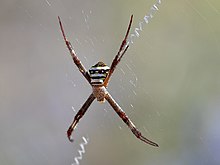Argiope aetherea
Appearance
| Argiope aetherea | |
|---|---|

| |
| Scientific classification | |
| Domain: | Eukaryota |
| Kingdom: | Animalia |
| Phylum: | Arthropoda |
| Subphylum: | Chelicerata |
| Class: | Arachnida |
| Order: | Araneae |
| Infraorder: | Araneomorphae |
| Family: | Araneidae |
| Genus: | Argiope |
| Species: | A. aetherea
|
| Binomial name | |
| Argiope aetherea (Walckenaer, 1841)[1]
| |
| Synonyms[1] | |
| |
Argiope aetherea is a common, large orb-web spider (family Araneidae). Like other species of Argiope, it is commonly known as the St Andrew's Cross spider, due to the characteristic cross-shaped web decorations female spiders often include in their webs. A. aetherea is similar in appearance to A. keyserlingi, however female A. aetherea are generally larger than A. keyserlingi.[2] Like most orb-web spiders, A. aetherea shows considerable sexual size dimorphism, with females being many times larger than males.
Distribution
Argiope aetherea is found from China to Australia.[1]
Subspecies
There exists a subspecies from New Guinea:
- Argiope aetherea annulipes Thorell, 1881
Gallery
-
Argiope aetherea with cross shaped web decoration
-
Argiope aetherea (female, ventral)
-
Female, dorsal
-
Same spider, ventral
-
Argiope aetherea
References
- ^ a b c "Taxon details Argiope aetherea (Walckenaer, 1841)", World Spider Catalog, Natural History Museum Bern, retrieved 2016-05-07
- ^ Levi H. W. (1983). "The Orb-Weaver Genera Argiope, Gea, and Neogea from the Western Pacific Region (Araneae: Araneidae, Argiopinae)" (PDF). MUSEUM OF COMPARATIVE ZOOLOGY. Harvard University. Retrieved 2017-11-26.
Wikimedia Commons has media related to Argiope aetherea.





